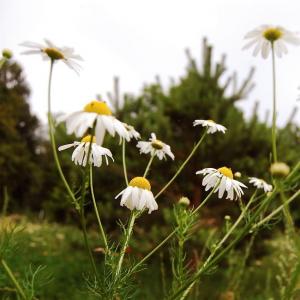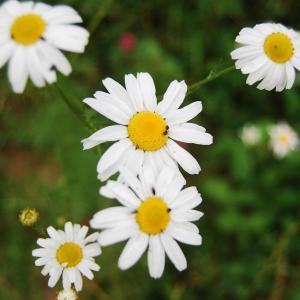
ROMAN CHAMOMILE ESSENTIAL OIL (CHAMAEMELUM NOBILE) - ESSENTIAL OILS

BASE / GENERAL DATA
Information submited: April 16, 2015 Modified: March 15, 2018 By: OperaDreamhouse
Botanical Name: Chamaemelum nobile (or Arthemis nobilis)
Common Method of Extraction: Steam distilled
Part Typically Used: Flowers
Color: Deep ink - blue
Consistency: Thin
Perfumery Note: Middle
Strength of Initial Aroma: Sweet, fruty, apple-like fragrance.
Chamomile is one of the most popular herbs in the Western world. There are two plants known as Chamomile: the more popular German Chamomile (Matricaria Recutita) and Roman, or English Chamomile (Chamaemelum Nobile). Although they belong to different species.
Chamaemelum nobile commonly known as Chamomile Roman, English Chamomile, Garden Chamomile, Ground Apple, Low Chamomile or Whig Plant, is a low perennial plant found in dry fields and around gardens and cultivated grounds in Europe, North America, and in Argentina. Chamaemelum Nobile is, along with Matricaria Chamomilla (Matricaria Recutita), an important source of the herbal product known as Chamomile.
Chamaemelum Nobile has daisy - like white flowers and procumbent stems. The leaves are alternate, pinnate, finely dissected, and downy to glabrous. The solitary, terminal flower heads, rising 8-12 cm. in above the ground, consist of prominent yellow disk flowers and silver - white ray flowers. The flowering time is June and July, and its fragrance is sweet, crisp, fruity and herbaceous.
Its history dates back as far as the ancient Egyptians who dedicated it to their Gods due to its curative properties, particularly when used for the acute fever known at the time as the Ague. Chamomile was also used by the Romans in medicines, beverages and incense.
During the Middle Ages this particular species of chamomile was commonly used as a "strewing" herb which helped to create a fragrant atmosphere at public gatherings and celebrations. When walked upon, theessential oil sacs in the flowers would release their wonderful fragrance into the air.
Depending upon the prevailing weather conditions, harvesting takes place during late June or July. To determine when the time is precisely right for harvesting, a small test distillation must be done every few days so that the resulting oil can be analysed using gas chromatography. If the oil is to meet the desired therapeutic quality for use in aromatherapy, certain constituents within the oil must also be at a particular level within the plant prior to distillation.
Once all the conditions are right, harvesting begins. It can take up to two weeks to cut the Chamomile in all of his fields. After cutting, the crop is allowed to sun - dry for a short period before being steam distilled to extract the beautiful pale blue essential oil. The flowers typically yield between 0,4 and 1,7% of essential oil.
Chemical structure:
Blue Chamomile essential oil has a high content of azulene, the active organic compound of Chamomile, which bears a blue color. Azulene has anti-inflammatory, skin healing properties.
Chamazulene does not show up as a constituent of Roman Chamomile until the distillation process becausechamazulene is bound with glycoside Matricine, which is a sugar molecule that becomes hydrolysed due to the pressure and heat of the steam distillation process of extracting the essential oil. The volatile azulenes become unbound and alpha-bisabolol and chamazulene are then freed and show as newly present constituents of Chamomile oil.
The main chemical components of Roman Chamomile oils are a-pinene, camphene, b-pinene, sabinene, myrcene, 1,8-cineole, y-terpinene, caryophyllene, and propyl angelate and butyl angelate.
Both Chamomile oils are extracted from the flowers by steam distillation, with the Roman Chamomile yielding about 1,7 % from fresh flowers and German Chamomileyielding about 0,2 - 0,4 %.
Common Method of Extraction: Steam distilled
Part Typically Used: Flowers
Color: Deep ink - blue
Consistency: Thin
Perfumery Note: Middle
Strength of Initial Aroma: Sweet, fruty, apple-like fragrance.
Chamomile is one of the most popular herbs in the Western world. There are two plants known as Chamomile: the more popular German Chamomile (Matricaria Recutita) and Roman, or English Chamomile (Chamaemelum Nobile). Although they belong to different species.
Chamaemelum nobile commonly known as Chamomile Roman, English Chamomile, Garden Chamomile, Ground Apple, Low Chamomile or Whig Plant, is a low perennial plant found in dry fields and around gardens and cultivated grounds in Europe, North America, and in Argentina. Chamaemelum Nobile is, along with Matricaria Chamomilla (Matricaria Recutita), an important source of the herbal product known as Chamomile.
Chamaemelum Nobile has daisy - like white flowers and procumbent stems. The leaves are alternate, pinnate, finely dissected, and downy to glabrous. The solitary, terminal flower heads, rising 8-12 cm. in above the ground, consist of prominent yellow disk flowers and silver - white ray flowers. The flowering time is June and July, and its fragrance is sweet, crisp, fruity and herbaceous.
Its history dates back as far as the ancient Egyptians who dedicated it to their Gods due to its curative properties, particularly when used for the acute fever known at the time as the Ague. Chamomile was also used by the Romans in medicines, beverages and incense.
During the Middle Ages this particular species of chamomile was commonly used as a "strewing" herb which helped to create a fragrant atmosphere at public gatherings and celebrations. When walked upon, theessential oil sacs in the flowers would release their wonderful fragrance into the air.
Depending upon the prevailing weather conditions, harvesting takes place during late June or July. To determine when the time is precisely right for harvesting, a small test distillation must be done every few days so that the resulting oil can be analysed using gas chromatography. If the oil is to meet the desired therapeutic quality for use in aromatherapy, certain constituents within the oil must also be at a particular level within the plant prior to distillation.
Once all the conditions are right, harvesting begins. It can take up to two weeks to cut the Chamomile in all of his fields. After cutting, the crop is allowed to sun - dry for a short period before being steam distilled to extract the beautiful pale blue essential oil. The flowers typically yield between 0,4 and 1,7% of essential oil.
Chemical structure:
Blue Chamomile essential oil has a high content of azulene, the active organic compound of Chamomile, which bears a blue color. Azulene has anti-inflammatory, skin healing properties.
Chamazulene does not show up as a constituent of Roman Chamomile until the distillation process becausechamazulene is bound with glycoside Matricine, which is a sugar molecule that becomes hydrolysed due to the pressure and heat of the steam distillation process of extracting the essential oil. The volatile azulenes become unbound and alpha-bisabolol and chamazulene are then freed and show as newly present constituents of Chamomile oil.
The main chemical components of Roman Chamomile oils are a-pinene, camphene, b-pinene, sabinene, myrcene, 1,8-cineole, y-terpinene, caryophyllene, and propyl angelate and butyl angelate.
Both Chamomile oils are extracted from the flowers by steam distillation, with the Roman Chamomile yielding about 1,7 % from fresh flowers and German Chamomileyielding about 0,2 - 0,4 %.

SPIRITUAL PRACTISES DATA

MEDICINE / HEALTH DATA

BEAUTY / COSMETICS DATA

FOOD / COOKING DATA
COMMENTS
No comments.




